The Microsoft Surface Go LTE Review: Unmatched Mobility
by Brett Howse on January 17, 2019 8:00 AM ESTBattery Life
The Surface Go offers just a 27 Wh battery capacity, which is about half the size of a typical Ultrabook released in the last year. It’s also 40% smaller than the battery offered in the Surface Pro 6 which is the longest life Pro released yet. On the plus side, the smaller display has a lower pixel density, which should help, and the processor doesn’t offer any Turbo modes which would move the power draw of the CPU higher.
As with all of our battery testing, the display is set to 200 nits brightness, to provide an even playing field for all devices. We run several different tests of varying intensity with our 2016 Web test being the most demanding.
2013 Light Web

Our lightest test is our oldest, and the Surface Go isn’t off to a great start. At under eight hours on this test, the battery life is much less than a current generation Ultrabook, and well back of the latest model Surface Pro as well. A couple of years ago, this would have been reasonable battery life. In fact, the Surface Go almost matches the Surface Pro 3 in terms of runtime on this test, but the goal posts have definitely moved.
2016 Web
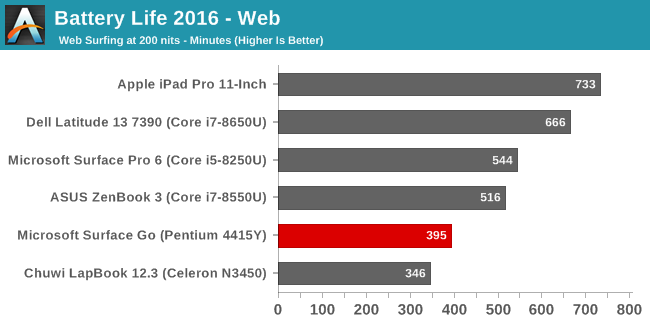
As with the previous test, the Surface Go struggles to keep up to the latest devices in this test as well. The Surface Pro 6 with a Core i5 offers 2.5 hours more battery life in this more demanding workload, which isn’t an insignificant amount of time. The tiny battery capacity hampers the Surface Go significantly here compared to other devices we’ve tested.
Movie Playback
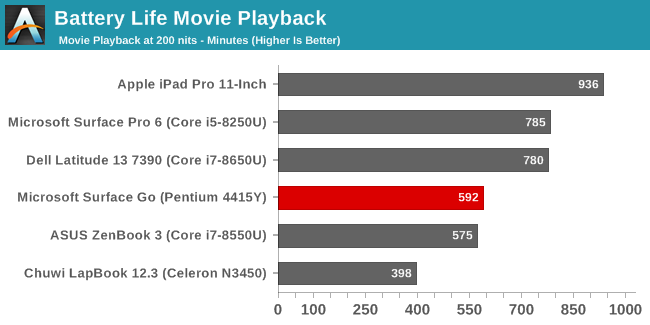
Movie playback is generally one of the best-case scenarios for modern devices since the media playback can be offloaded to the video decode unit, allowing the rest of the processor to go to sleep for much of the time. The Surface Go is still shy of the impressive results seen in the latest Surface Pro, but does get awfully near the 10-hour mark that Microsoft advertises for this device.
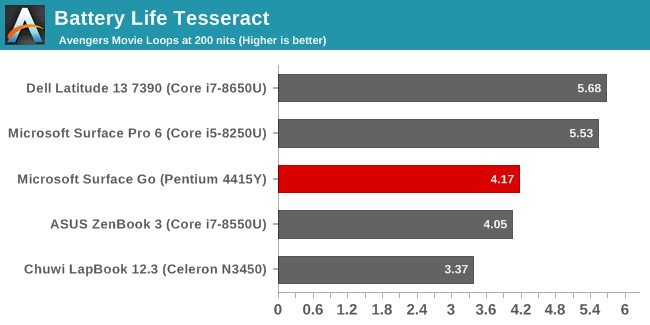
In terms of how many movies can you watch before the device runs out of juice, the Surface Go is pretty stout in this regard, with well over four runnings of The Avengers worth of battery life.
Normalized Results
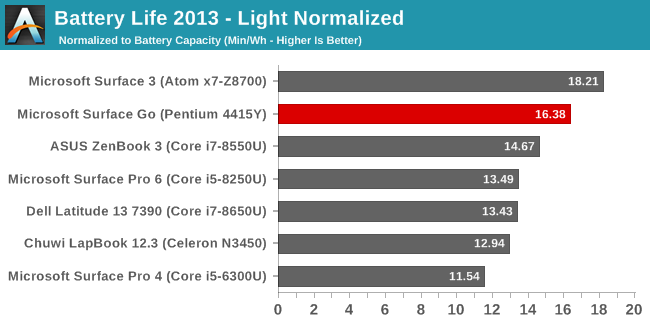
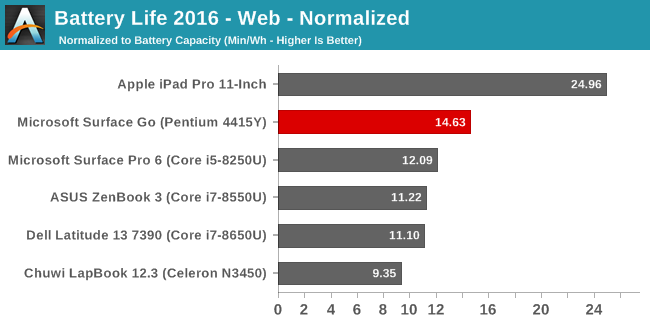
By removing the battery capacity from the equation, we can see how many minutes a device can last per Watt-Hour capacity of the battery. The Surface Go, mostly thanks to the display, does quite well in terms of efficiency. Put another way, on our 2016 Web test, the Surface Go averages 4.1 Watts of power draw with the display at 200 nits, and a Surface Pro 6 draws just a hair under 5 Watts during the same workload. So really, the less than amazing battery life really just comes down to not being able to fit more capacity in the Surface Go. The device is one of the most efficient we’ve tested.
Charge Time
The previous small form factor convertible tablet from Microsoft was the Surface 3, and it took a very long time to charge. Microsoft had outfitted it with a Micro USB port for charging, and then shipped it with just a 13 Watt AC adapter. It seems the company has learned its lesson there, and the Surface Go now offers the same Surface Connect port as the rest of the Surface lineup. It also ships with a 24 Watt adapter.
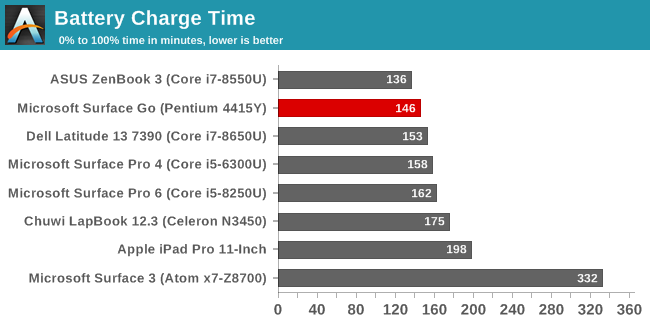
The result is a much better charge time than the Surface 3, and thanks to the smaller capacity battery, better than the Pro as well.
In addition, the Surface Go offers a USB-C port which will also do charging. This is a huge benefit for portable device such as this, since it would let you leave the main charger at home or work, and then use the same charger you use for your phone to top up the Surface Go. Microsoft seems to have an animosity towards USB-C, but this is the perfect device for them to offer it on.










79 Comments
View All Comments
Ashinjuka - Saturday, January 19, 2019 - link
Cats and dogs lying down together.TheinsanegamerN - Saturday, January 19, 2019 - link
Mass hysteriaDeath666Angel - Thursday, January 17, 2019 - link
"while being decent in legacy code" I'm not holding my breath.But I am serious surprised that this thing is worse than Atom based Celeron and Pentium CPUs. I guess not having any turbo really hurts it.
tipoo - Thursday, January 17, 2019 - link
The Snapdragon 845 Windows laptops showed about a 50% loss in running x86 code fwiwTheinsanegamerN - Saturday, January 19, 2019 - link
*on average.50% on average is horrible, because remember, "on average" means half are worse then that. You could have two apps, one 25% slower and one 75% slower, and hit that 50% mark. Users of the second app, however, would not be happy.
Anything with FPU intensive code or spaghetti code dogs down to near unusability on ARM. Most of the well running apps on windows ARM are basic apps that dont need intensive processor resources, apps simple enough to port to ARM natively.
deathBOB - Thursday, January 17, 2019 - link
Ooof what a dog.Too bad, it’s a cool design.
PeachNCream - Thursday, January 17, 2019 - link
The word "flagship" is necessary for something to be cool these days. Anandtech only grants the flagship moniker to thousands of truly impressive mid-range products.cknobman - Thursday, January 17, 2019 - link
Close but no cigar.Microsoft charging $100 for the stupid type cover is downright robbery.
Maybe if it was just that in isolation I could give in but there are just too many other comprimises.
The 64GB hdd in the base model is too small and would barely even support updating Windows 10 properly in the future.
Intel with their price raping strategy refuses to make offer a processor with enough performance at a decent price. If this same chip just had a turbo boost capability it would be fine.
The battery is too small. Again this in isolation would not be a big deal but combined with the other compromises it just too much.
So by the time you add a keyboard and enough storage you are spending WAY TO MUCH $$$ to still have crippled performance and battery life.
tipoo - Thursday, January 17, 2019 - link
Also that the 64GB base model is horribly slow eMMC.Prestissimo - Saturday, January 19, 2019 - link
$800 USD to be exact, excluding shipping and taxes. For a 10" Windows tablet PC with PENTIUM and 3 HOURS of actual battery life that is NOT REPAIRABLE.This is as hilarious a fiasco as that Google's Chromebook thing they've been making for some time.